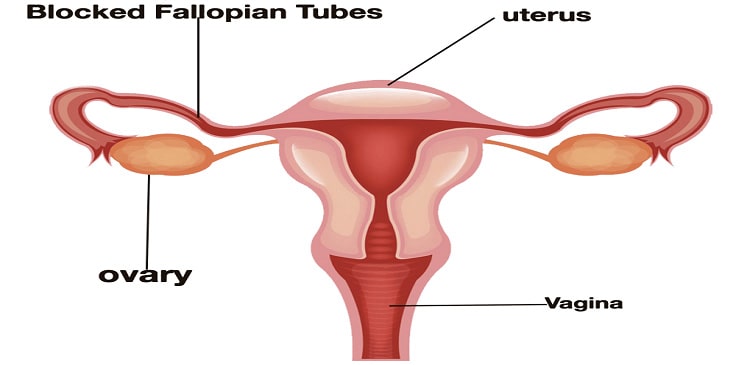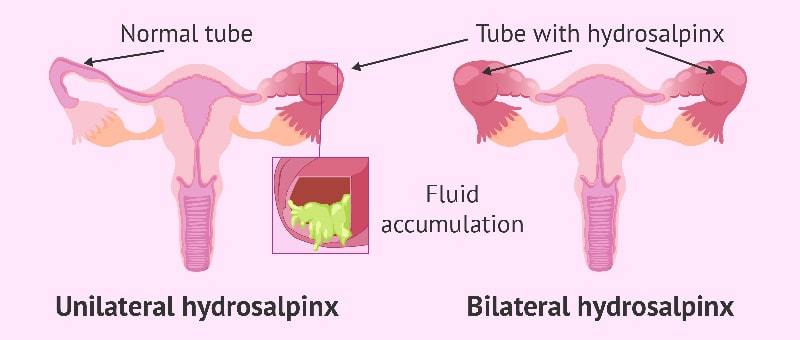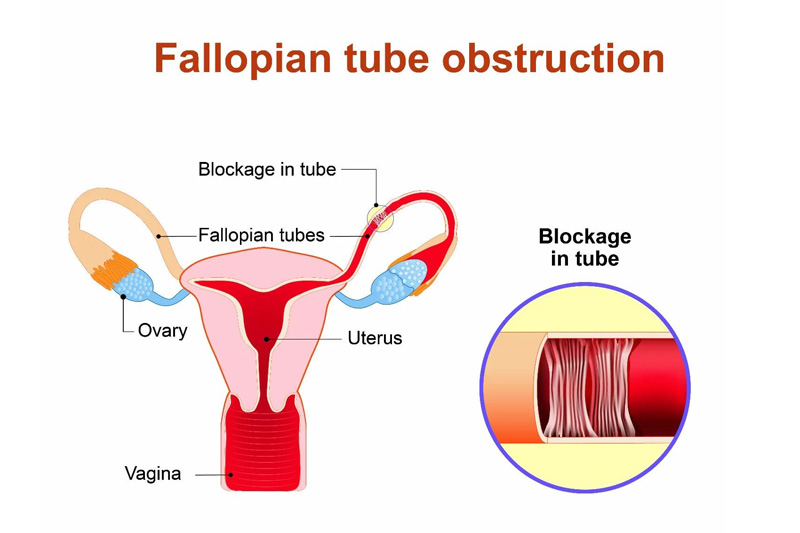Tubal Factors
Tubal factor infertility occurs when the fallopian tube(s) prevent sperm from reaching the ovary to fertilize an egg or prevent a fertilized embryo from reaching the uterus for pregnancy. The fallopian tubes on either side of the uterus are the connections between the uterus and the ovaries.
Sperm fertilizes the egg in the outer one-third of the tube and the embryo is then moved towards the uterus for implantation.
Tubal factor infertility can affect 50% of all infertility cases.
Fallopian tubes are the connections between the uterus and the ovaries.
Sperm fertilizes the egg in the mid section of the tube and the embryo is then moved towards the uterus for implantation.
At Footsteps To Fertility Centre, we are honored to have helped many couples receive the gift of parenthood, and being given the opportunity to guide them through their difficult period of infertility.
Feel free to contact us, chat with us or directly reserve an appointment below. We are more than happy to walk with you through your journey and help you achieve the family of your dreams.
What causes tubal factor infertility?
Infections, abdominal surgery, and diseases such as tuberculosis ( TB ) and endometriosis can cause scarring between the end of the fallopian tube and ovary. Chlamydia and gonorrhea are two common sexually transmitted infections that can cause tubal infertility. Surgery can also damage your fallopian tubes.
Pelvic Inflammatory Disease (PID) can also travel from the cervix through the uterus to the tubes, which can ultimately cause the delicate inner lining of the tubes to become permanently scarred. The opening of the tube next to the ovary may become partially or completely blocked; scar tissue will often form on the outside of the tubes and uterus.
Symptoms and Diagnosis of Tubal Factor Infertility
Most women with tubal infertility are asymptomatic. Often they don’t realize their fallopian tubes are blocked until they consult a doctor for infertility, though women with extensive tubal damage may experience chronic pelvic pain.
To confirm whether or not one or both fallopian tubes are blocked, your doctor may perform one of these two procedures:
- Hysterosalpingogram (HSG) is an X-ray in which a dye is passed through the cervix into the uterus. The dye can be followed through the fallopian tubes to see if they are open. If the tubes are open, it does not mean that they are functioning normally. There may be extreme scarring or blockage inside the lining of the tube that cannot be detected with this test.
- Laparoscopy is a minimally invasive surgical procedure involving a small incision just below the belly button with the insertion of a small surgical instrument, called a laparoscope, to view the fallopian tubes. The laparoscope can determine whether or not the tubes are blocked or if there are other issues such as scar tissue adhesions.
How is Tubal Factor Infertility Treated?
If your tubes are found to be blocked, scarred, or damaged, your treatment options include in vitro fertilization (IVF) or surgery.
- In vitro fertilization (IVF): Although a few tubal problems are correctable with surgery, women with severely damaged tubes have such poor chances of achieving pregnancy naturally that IVF offers them the best option for a successful pregnancy. Because very badly damaged tubes may fill with fluid (hydrosalpinx) and lower IVF success rates, your physician may recommend the removal of damaged tubes prior to IVF.
- Surgery: If your tubes are not badly damaged, surgery might help you get pregnant naturally. Your chance of conceiving after surgery is better if you are young and have a minimal amount of scar tissue blocking the tubes, and if your male partner has healthy sperm.

Conditions associated with tubal factor infertility

Advanced Fertility and Gyne Center. Image source: Fallopian Tube Blockage. Accessed via https://www.advancefertility.in/fallopian-tube-blockage-causes-diagnosis-treatment-and-complications
What is Tubal Disease?
Tubal disease is a common cause of female infertility. The fallopian tubes are very delicate structures that are responsible for picking up the egg and providing the site for fertilization of the egg as well as early embryo development and transport to the uterine cavity.
Infertility is one of the most vital problems in recent years. If tubes are blocked, sperm and the egg cannot meet and infertility follows.
Symptoms of Tubal Disease
Some women with blocked/damaged tubes experience symptoms while others do not.
Possible symptoms include abdominal pain, fever, unusual vaginal discharge and pain when menstruating/urinating/having sex.
Another common symptom of tubal disease is infertility. If you don’t get pregnant after one year of trying (or after six months), your doctor will order a specialized X-ray to check your fallopian tubes, along with other basic fertility testing.
Causes of Tubal Disease
- Scar tissue resulting from endometriosis or abdominal or gynecological surgery (bowel surgery, cesarean section, ruptured appendix.) can block the egg from entering or traveling down your fallopian tube to meet the sperm.
- Sexually Transmitted Diseases that go undetected or untreated, such as chlamydia can damage the cilia (tiny hairs lining the fallopian tubes) that help to transport the egg. Gonorrhea can damage the fallopian tubes irreparably. Without normal cilia, the egg may not meet the sperm, or if an egg becomes fertilized, it may not be able to travel to the uterus. This can result in an ectopic pregnancy, which can further damage your tube.
- Tubal ligation (having your tubes tied to prevent pregnancy) and/or subsequent reversal of tubal ligation can also leave your fallopian tubes damaged.
Types Of Tubal Disease
- Scar tissue resulting from endometriosis or abdominal or gynecological surgery (bowel surgery, cesarean section, ruptured appendix.) can block the egg from entering or traveling down your fallopian tube to meet the sperm.
- Sexually Transmitted Diseases that go undetected or untreated, such as chlamydia can damage the cilia (tiny hairs lining the fallopian tubes) that help to transport the egg. Gonorrhea can damage the fallopian tubes irreparably. Without normal cilia, the egg may not meet the sperm, or if an egg becomes fertilized, it may not be able to travel to the uterus. This can result in an ectopic pregnancy, which can further damage your tube.
- Tubal ligation (having your tubes tied to prevent pregnancy) and/or subsequent reversal of tubal ligation can also leave your fallopian tubes damaged.
Types Of Tubal Disease
1. Hydrosalpinx

inviTRA. Image source: Hydrosalpinx in one or both tubes. Accessed via https://www.invitra.com/en/hydrosalpinx/hydrosalpinx
A hydrosalpinx is a condition that occurs when the fallopian tube is filled with serous or clear fluid near the ovary. The fluid accumulates there because of an acute or chronic inflammatory process in the tube. This is typically due to a prior pelvic infection and inflammation.
If both the fallopian tubes are blocked in this manner, then it is almost impossible to get pregnant naturally.
If the tubes are damaged from the inside (intrinsic) due to prior pelvic infection, repair of such tubes does not yield high success rates.
Treatment of hydrosalpinx depends on the goals of the patient. Laparoscopic surgery can be used to create a new opening at the end of the tube, in a procedure called neosalpingoscopy.
2. Salpingitis Isthmica Nodosa (SIN)
Salpingitis isthmica nodosa is one type of proximal tubal disease which is difficult to correct and deserves special mention.
The cause of Salpingitis Isthmica Nodosa is not known; however, it is associated with endometriosis is thought to be related to prior inflammation in the tube.
Women suffering from SIN are at increased risk for infertility and ectopic pregnancy (pregnancy in the fallopian tube). IVF is commonly recommended for individuals with SIN.
3. Proximal tubal occlusion
Proximal Tubal occlusion is blockage of the fallopian tubes where they connect to the uterus. Some of the causes are fibroids, mucus plugs, endometriosis, inflammation, or scarring.
Some women diagnosed with proximal tubal occlusion on HSG actually have normal tubes after further investigation via laparoscopy. Diagnosis can be done by injecting a blue dye into the uterus under higher pressure while the patient is under anesthesia.
If there is true proximal tubal occlusion, IVF is the only solution.
4. Cilia Syndrome
This condition occurs when the fallopian tubes are open but are not functioning. Infections, such as chlamydia, can damage the cilia (tiny hairs lining the fallopian tubes) that help to transport the egg.
Without normal cilia, the egg may not meet the sperm, or if an egg becomes fertilized, it may not be able to travel to the uterus. This can result in an ectopic pregnancy, which can further damage your tube. Sometimes tubes may appear open but have no function due to damaged cilia. This condition would require IVF treatment.
How Does Tubal Disease Cause Infertility?
If the fallopian tubes have adhesions or scar tissue around them, it can block an egg and subsequent embryo from reaching the uterus, causing infertility.
When the tubes are partially blocked by adhesions, sperm may meet the egg in the fallopian tube instead of in the uterus, and ectopic pregnancy may occur.
Diagnosis and Treatment of Tubal Disease
Our team at Footsteps To Fertility wants to help as many patients as we can who suffer from tubal disease – especially those that wish to become pregnant. Thanks to our highly skilled staff and state-of-the-art facilities, we are able to provide the best diagnostic testing and treatment options available
Your medical history and a pelvic exam are necessary for diagnosing tubal disease. You may need one or more of the following tests:
- Saline Sonohysterogram – a procedure that uses ultrasound to detect masses in your uterus that may be blocking your fallopian tubes.
- Hysterosalpingogram – Dye is injected vaginally through the cervix and x-rays are taken to evaluate the inside of the uterus (endometrial cavity) as well as the fallopian tubes.
- Laparoscopy – Of the diagnostic tests, laparoscopy allows for the most comprehensive evaluation. An outpatient surgical procedure in which your doctor uses a laparoscope inserted into the abdominal cavity through a small incision in or near the belly button to look for or visualize and sometimes remove scar tissue or endometrial tissue blocking the fallopian tubes.
The most common treatment for tubal disease is IVF. At Footsteps To Fertility Centre in Kenya, IVF is the fertility treatment we offer patients with tubal disease, as the eggs need to be removed from the ovaries in order to be fertilized.
The treatment that’s right for you depends on various factors such as your age and ovarian reserve our fertility specialist will advise you on the best treatment option and devise a tailor-made treatment plan on the basis of a scan and your medical history.
Blocked Fallopian Tubes

Facty Health. Image source: Symptoms and Treatments of Pelvic Inflammatory Disease. Accessed via: https://facty.com/ailments/body/symptoms-and-treatments-of-pelvic-inflammatory-disease/2/
Fallopian tubes connect a woman’s ovaries to her uterus, allowing an egg to travel through the fallopian tubes to the uterus.
Most women have two ovaries (left and right) where their egg follicles are stored. Each month, a follicle matures and releases an egg into the fallopian tubes.
Fallopian tubes are two thin tubes, one linking to each ovary to help move the mature egg from the ovaries to the uterus.
When there is an obstruction in one or both of the fallopian tubes the condition is known as blocked fallopian tubes or tubal factor infertility. This can occur on one or both tubes and is one of the main causes of female infertility.
If you have a blockage in your fallopian tubes, our specialists at Footsteps To Fertility Centre are happy to help you diagnose this issue and provide suitable treatment options to help you achieve a pregnancy.
How do I know if I have blocked fallopian tubes?
Unlike other common gynecological conditions, blocked fallopian tubes rarely show any symptoms. Some women may have blocked fallopian tubes their entire life and not experience any symptoms.
A unique and rarer type of blocked fallopian tube called ‘hydrosalpinx’ may cause lower abdominal pain and unusual vaginal discharge, but not every woman will have these symptoms.
This is when your fallopian tube is blocked and filled with a clear watery fluid. The inflammatory fluid can leak into the uterine cavity and prevent normal implantation of the embryo.
What causes blocked fallopian tubes?
There are a number of reasons why your fallopian tubes can be blocked:
- Pelvic inflammation is the most common cause of blocked tubes. The inflammation usually happens inside your fallopian tubes which is usually the case with sexually transmitted infections (STIs) such as gonorrhea or chlamydia. The inflammation can also occur outside your tubes due to an infection from another organ such as the appendix.
- Blocked from birth (congenital tubal obstruction) – A very rare condition that is present from birth.
- Accidental damage following other surgery – It is possible for your fallopian tubes to be blocked by excessive scar tissue from previous surgery
- Severe endometriosis – Fallopian tubes can become damaged or blocked in severe cases of endometriosis due to adhesions or scar tissue.
- Bilateral Tubal Ligation (BTL) – Many women have BTL, voluntarily after the birth of their children due to having achieved their desired family size. If this is done too early, many women regret it later on and may opt to have another child. The only way to achieve this is through an IVF cycle.
How can the fallopian tubes affect fertility?
When ovulation occurs each month, an egg is released from one of the ovaries. It travels through the fallopian tubes and towards the uterus. The sperm need to swim from the cervix up into the uterus and into the fallopian tube where the egg has been released.
Fertilization usually takes place in the fallopian tube when the egg and the sperm meet.
If one or both of the tubes are blocked, the sperm cannot reach the egg.
This means that fertilization cannot happen and a pregnancy cannot be achieved. If only one of your tubes is blocked, then your specialist may suggest medication that encourages more frequent ovulation on the side of the unblocked tube.
Although blocked fallopian tubes can make it difficult to achieve a pregnancy, they are relatively easy to diagnose for a specialist.
Our caring, compassionate and discreet team at Footsteps To Fertility Centre is highly equipped with the skills and expertise to help you conceive your little bundle of joy.
How to diagnose blocked fallopian tubes?
If an individual or couple is struggling to conceive for no known reason, fertility specialists will often investigate the possibility of blocked tubes. There are several medical tests that can detect some type of blockage.
- Hysterosalpingogram (HSG) – An HSG is an x-ray test that uses a contrasting dye to view obstruction in the fallopian tubes. The dye is inserted into a thin tube that is placed through the vagina and into the uterus. Once the uterus is filled with this dye, it will then spill into the fallopian tubes. X-rays are then taken to see if there is anything blocking the tubes. It is usually carried out without a general anesthetic.
- Sonohysterography – Sonohysterography is a non-invasive procedure where ultrasound imaging is used instead of the potentially more damaging x-rays. Similar to the HSG, a thin tube is placed through the vagina and into the uterus to see if there is a blockage in the tubes. The ultrasound examination can also diagnose a hydrosalpinx and other issues such as ovarian cysts, endometrial polyps and uterine fibroids. It can be carried out without a general anesthetic.
- Chromotubation – Chromotubati fallopian tube. The dye for this procedure is different from a HSG as it cannot be seen on is performed during laparoscopy so that your specialist can see the dye spilling from the on an X-ray. This test is considered the most reliable way to determine if you have blocked tubes but does require surgery and a general anesthetic.
How can blocked fallopian tubes be treated?
Once our fertility specialist has diagnosed blocked fallopian tubes there are many different ways that they can be treated and unblocked.
If you only have one tube that is blocked, our fertility specialist may recommend continuing to try to conceive naturally as it is still possible to conceive if all other factors are normal.
If both tubes are blocked on HSG, an additional assessment may be recommended via laparoscopic surgery. The correction of blocked fallopian tubes is not always possible surgically and only about 7% are actually corrected. This may mean that IVF may be the only option if they are truly blocked tubes. IVF bypasses the need for fertilization to occur in the fallopian tubes by placing an embryo directly into the uterus.
If you are concerned about your fertility and think you may have blocked fallopian tubes, consulting a specialist will help put your mind at ease, answer any questions that you may have and can help you on the right path to pregnancy.
Book Your
Appointment today!
Make an Appointment


